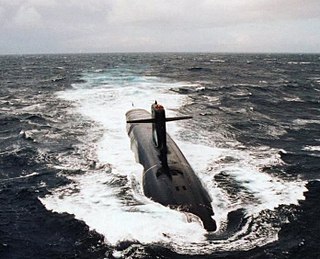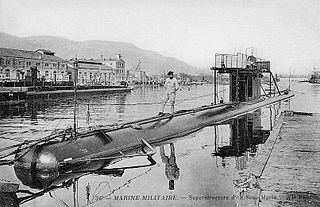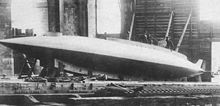
A ballistic missile submarine is a submarine capable of deploying submarine-launched ballistic missiles (SLBMs) with nuclear warheads. These submarines became a major weapon system in the Cold War because of their nuclear deterrence capability. They can fire missiles thousands of kilometers from their targets, and acoustic quieting makes them difficult to detect, thus making them a survivable deterrent in the event of a first strike and a key element of the mutual assured destruction policy of nuclear deterrence.

The Force de frappe, or Force de dissuasion after 1961, is the French nuclear deterrence force. The Force de dissuasion used to be a triad of air-, sea- and land-based nuclear weapons intended for dissuasion, the French term for deterrence. Following the end of the Cold War, France decommissioned all its land-based nuclear missiles, thus the Force de dissuasion today only incorporates an air- and sea-based arsenal.

The Le Redoutable-class submarine was a ballistic missile submarine class of the French Navy. In French, the type is called Sous-marin Nucléaire Lanceur d'Engins (SNLE), literally "Missile-launching nuclear submarine". When commissioned, they constituted the strategic part of the naval component of the French nuclear triad, then called Force de frappe.

Le Redoutable was the lead boat of her class of ballistic missile submarines in the French Marine Nationale.
The Barracuda class is a nuclear attack submarine, designed by the French shipbuilder Naval Group for the French Navy. It is intended to replace the Rubis-class submarines. Construction began in 2007 and the first unit was commissioned on 6 November 2020. The lead boat of the class, Suffren, entered service on 3 June 2022.

The Rubis class is a class of nuclear-powered attack submarines operated by the French Navy. It comprises six boats, the first entering service in 1983 and the last in 1993. Two additional units originally planned were cancelled as a result of post-Cold War budget cuts. All six submarines of the Rubis class are based at Toulon and are part of the Escadrille de sous-marins nucléaires d'attaque. Smaller than contemporary designs of other major world navies, the Rubis class shares many of its system designs with the conventionally-powered Agosta class. In the late 1980s, the Rubis class was proposed to Canada in the context of their plan to acquire nuclear-powered submarines.

The Strategic Ocean Force has been the synonym of the French Submarine Forces since 1999, which the commandant commands the ensemble related to, along with the squadron of nuclear attack submarine.

A nuclear triad is a three-pronged military force structure of land-based intercontinental ballistic missiles (ICBMs), submarine-launched ballistic missiles (SLBMs), and strategic bombers with nuclear bombs and missiles. Countries build nuclear triads to eliminate an enemy's ability to destroy a nation's nuclear forces in a first-strike attack, which preserves their own ability to launch a second strike and therefore increases their nuclear deterrence.

The Triomphant class of ballistic missile submarines of the French Navy is the active lead boat class of four boats that entered service in 1997, 1999, 2004, and 2010. These four superseded the older Redoutable class, and they provide the ocean-based component of France's nuclear deterrent strike force, the Force de dissuasion. Their home port is Île Longue, Roadstead of Brest, Western Brittany.

The M20 was a French submarine-launched ballistic missile (SLBM) deployed on the nuclear Redoutable-class submarines from 1977. It was withdrawn from service by 1991.

The Redoutable-class submarines were a group of 31 submarines built between 1924 and 1937 for the French Navy. Most of the class saw service during the Second World War. The class is also known in French as the Classe 1 500 tonnes, and they were designated as "First Class submarines", or "large submarine cruisers". They are known as the Redoutable class in reference to the lead boat Redoutable, in service from 1931 to 1942. The class is divided into two sub-class series, Type I, known as Le Redoutable and Type II, Pascal.

The Émeraude-class submarines consisted of six submarines built for the French Navy during the first decade of the 20th century. One boat was sunk and another captured during the First World War and the survivors were scrapped after the war.

Pluviôse (Q51) was the name ship of her class of 18 submarines built for the French Navy in the first decade of the 20th century.

French submarine Fresnel (Q65) one of 18 Pluviôse-class submarines built for the French Navy in the first decade of the 20th century.
French submarine Cugnot (Q76) was one of 18 Pluviôse-class submarines built for the French Navy during the first decade of the 20th century.

Saphir was one of six Émeraude-class submarines built for the French Navy in the first decade of the 20th century.

Watt (Q75) was one of 18 Pluviôse-class submarines built for the French Navy in the first decade of the 20th century. Commissioned in 1910, she served during World War I and was stricken in 1919.

Redoutable was the lead ship of the Redoutable-class submarines of the French Navy launched in 1928 at Cherbourg, France. It participated in the Second World War, first on the side of the Allies from 1939 to 1940, then on the side of the Axis for the rest of the war. She was scuttled by the French on 27 November 1942 to prevent her capture by the Germans during their advance on Toulon, but was then refloated by the Italians in 1943. On 11 March 1944 she was sunk by bombs from Allied aircraft.

Le Conquérant was a French Navy Redoutable-class submarine of the M6 series commissioned in 1936. She participated in World War II, first on the side of the Allies from 1939 to June 1940, then in the navy of Vichy France. She was sunk in November 1942.





















